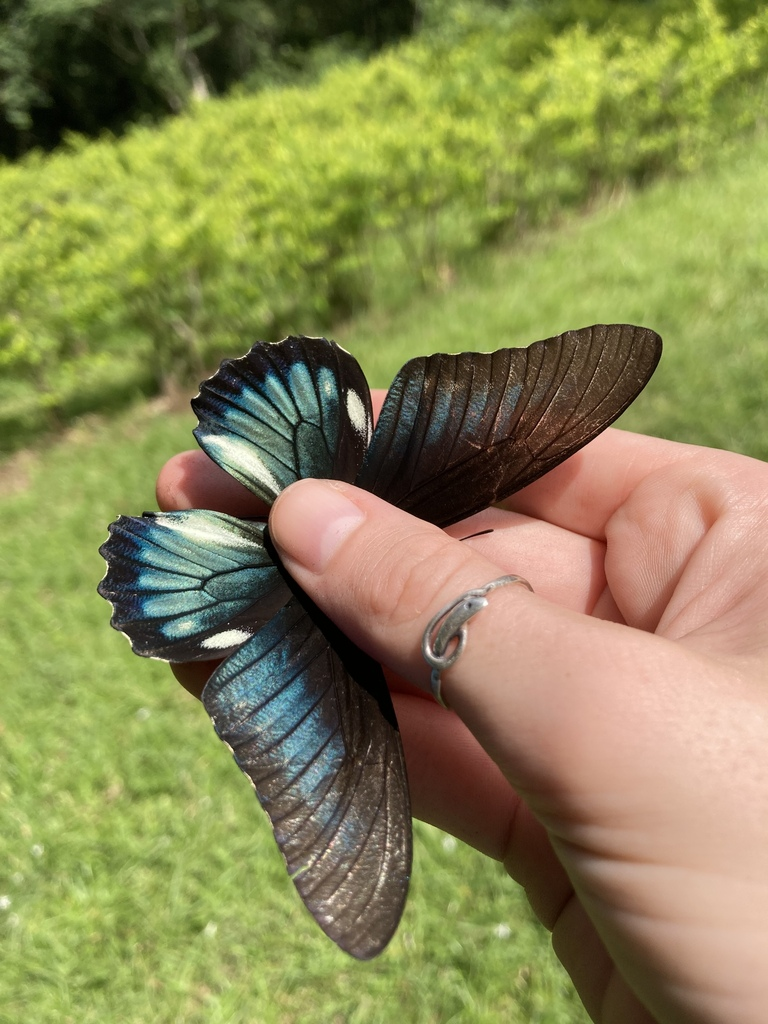Battus lycidas has at least four non-Latin names; Lycidas Swallowtail, from its Latin name; Cramer's Swallowtail, for the naturalist who first described it; Yellow Trailed Swallowtail, from its markings; and, in Spanish, Mariposa cola de golondrina azul, the Blue Swallowtail, from its color. The wings are dark but, when they catch the light just right, they iridesce brilliant blue.
Photo donated to Inaturalist by Jmmelendez, who notes that it was taken in September, in Mexico.
The species is not really rare so much as sparse. It likes a lot of space. It's found from Mexico to Brazil, but not very often, nor in great numbers. It seems to have multiple generations in a year, but the greatest number of butterflies fly in May and June. Nature parks' and naturalists' web sites celebrate its occasionally being found as far east as Trinidad island, once even as far north as Niagara Falls (where it might have stowed away on a ship or escaped from a zoo). Lise Winer's Dictionary of the English-Creole of Trinidad & Tobago mentions that, although the butterfly is rarely seen, it's well enough remembered that some Trinidadians familiarly call it "lycidas" with a lower-case l.
It is found in art around the world, and is kept in captivity in some nature parks. People love to snap, draw, and paint pictures of it. Readers who have looked for our "Save the Butterflies" designs on Zazzle know how many Zazzle designers are inspired by these broad-winged beauties--or by the gigantic Blue Morphos; it's not always easy to be sure which species some designers are trying to paint, but they love the bright blue color these large and extra-extra-large species have in common.
It is one of the butterflies that are classified as Swallowtails because of the structure of their wings but do not, in fact, have real "swallow tails" on their hand wings, The edges of the hind wings are deeply scalloped and may look, as on the individual above, as if they had tried to grow tails but not quite succeeded.
Why are they called Battus lycidas? Among North American butterflies this genus most closely resembles the Asian genus Atrophaneura, sometimes called Batwings. However, before the English name "Batwings" had become widespread, it was traditional to name Swallowtail butterflies after heroes of ancient literature. In mythology Battus, a shepherd boy who reported thieves to his employer, wasn't much of a hero, but in history there was a King Battus of Cyrene who came a little closer to being one. At least the historical Battus was a war chief. The name may mean "combative, warlike." In ancient literature Lycidas was the name of another shepherd. In more recent literature, "Lycidas" was revived as a fictional name for John Milton's school friend, Edward King, who was drowned in a shipwreck in 1637. Vergil had not portrayed his Lycidas as a hero, but Milton portrayed his friend as a hero-to-be whose good qualities the world lost.
Upper wing color patterns show the gender in this species. Cramer, who first described and named this species in 1777, thought they were two different species; he named the female Papilio lycidas and the male P. erymanthus. Females have bands of white or yellow spots across the wings, as shown above. Males have very conspicuous scent folds that make the "trailing edge" of each hind wing look white or yellow. Body colors are also different: males' abdominal segments are yellow above and black with white spots below, while females are black all over.
Even females show scent folds. The scent is not a conspicuous figure to human observers but probably smells very strong and distinctive to the butterflies.
Wingspans are typically about four inches, sometimes more, often less.
In some lights the upper surface of the wings looks more green than blue:
The undersides of the wings usually look black or brown, with a border of red spots around the hind wings and the male's "trail" stripes visible. As in the Atrophaneuras, the scales that give the wings their color can be thin, and especially the upper wings can look pale and translucent in between their black veins.
As shown, the butterflies drink a lot of water from sandy banks and muddy puddles, but also pollinate some wild flowers. They are found at fairly low elevations, always below 3000 feet, often near rivers. Like the Asian Batwings, they fly high, and the females spend much of their time flying around big fast-growing vines that climb up tall trees, but they are often seen when they come out to stream and river banks to sip water.
They have appeared on postage stamps.
Their life cycle remains to be fully documented.
The pupa is described as pale green,







No comments:
Post a Comment